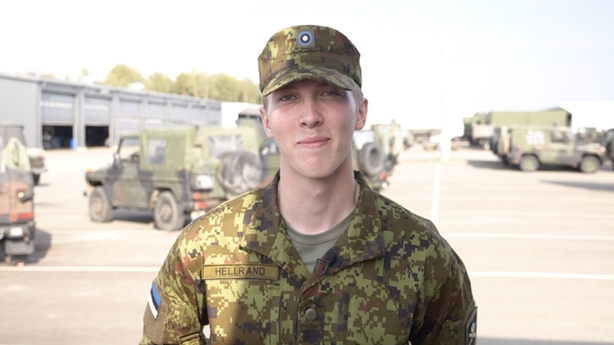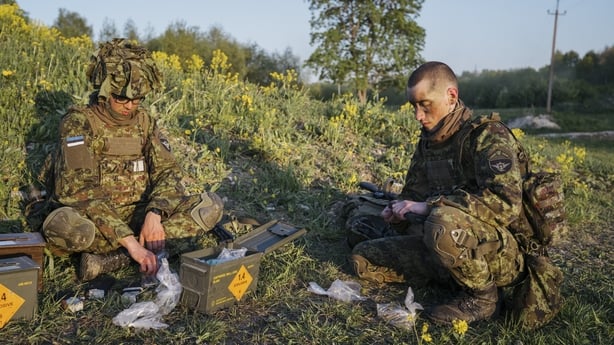Karl Hellrand, a 19-year-old from the Estonian capital Tallinn, is fixing the rear lights on an army jeep.
Instead of taking up a place to study mathematics at university straight after secondary school, he is serving 11 months of conscription in Estonia's Defence Forces.
Almost 4,000 young Estonian men, aged 18 to 26, are required to serve in the country's military each year.
"Conscription service is important, especially for smaller countries like Estonia," Mr Hellrand told RTÉ News at Tapa army base, located halfway between Tallinn and the border with Russia.
"There aren't as many people to go around and you need a force to defend yourself with. So a conscription army is our best bet".
Mr Hellrand began his service in July and has already learnt how to handle a weapon and go on military manoeuvres. But the army also teaches conscripts how to fix and drive jeeps.
By the end of his year in uniform, the future university student will know how to drive a mobile howitzer - a devastating piece of military hardware.
Estonia’s defence forces of 44,000 men and women is largely based on a system of reservists.
Russia's invasion of Ukraine has forced neighbouring countries to prepare for war. NATO member Estonia is one of several countries where conscription has been rebooted and expanded. So, what's it like to be a teenager training for conflict and crisis?
— RTÉ News (@rtenews) October 9, 2024
Read https://t.co/cYQjN2fIOz pic.twitter.com/gyxrbsUtUd
Since 2022, the size of its territorial defence has doubled from 10,000 to 20,000 and the number of women who have volunteered for Estonia's defence league has increased from 4,000 to 5,000.
For a small country of 1.3 million inhabitants, it is a sizeable army to call upon in the event of a crisis, but Estonia's foreign intelligence agency reported earlier this year that Russia was doubling the size of its troops to about 40,000 in the vicinity of Estonia.
The same agency also reported in February that Russia was forming a new army corps close to the border with Finland.
During my visit to the base at Tapa, an Estonian officer said that they are preparing for a scenario of "when Russia will attack". There are no "ifs" in the Estonian defence doctrine at present.

Russia's invasion of Ukraine has served to vindicate long-held suspicions in the Baltics over Moscow's true intentions towards countries that were once part of the USSR.
Estonia, Latvia and Lithuania were deprived of their statehood during 45 years of Soviet occupation and memories of those times have influenced their approach to defence.
Unsurprisingly, all three countries put in their paperwork to join NATO in the late 1990s, joining the alliance in 2004.
Since Russia’s all-out war on Ukraine, Estonia has increased its spending on defence from 2% to 3.2% of GDP, and is increasing the number of draftees from 3,500 in 2022 to 4,000 by 2026.
The government in Tallinn intends to increase defence spending to 3.7% of GDP by 2026 too. NATO currently sets 2% of GDP as the target member states to spend on defence.
"We are pragmatic because we have hostile neighbour," Hanno Pevkur, Estonia’s defence minister, told RTÉ News following a press briefing at his ministry in Tallinn.
"We don't see that there will be a change in the nearest future in Russia which means that we have to be prepared," he said, adding that Estonia does not have the luxury to "give away a centimetre of Estonian land".
The territory occupied by Russia in Ukraine at present, Mr Pevkur pointed out, is equal to the size of Estonia, Latvia and half of Lithuania.

While at Tapa army base, the home of Estonia’s NATO battalion, I got to see up close some of the military hardware that Estonia has acquired in recent years.
The army’s artillery battalions include 36 South Korean-made mobile howitzers - a massive self-propelled gun that costs in excess of $10 million (€9.06m) per model.
Estonia’s defence ministry also announced last week that it will spend an additional €1.6 billion on ammunition by 2031, bringing its expenditure on ammunition to $4bn over the course of this decade.
Building up a sizeable arsenal and maintaining a larger army is soon going to cost Estonian taxpayers.
Their government’s so-called 'defence tax’, announced last month, will increase the rate of VAT by 2% from next year and, from 2026, raise the rate of income tax by 2% and place an additional 2% tax on corporate profits.
A similar approach to defence has taken place in the two other Baltic countries.
Latvia plans to spend 3% of its GDP on defence by 2027 and Lithuania has pledged to meet the same target by next year.
Latvia re-introduced conscription for men last year and the country's defence minister recently said he was in favour of introducing the draft for women from 2028.
Lithuania brought back its draft in 2015, one year after Russia had illegally annexed Crimea and begun its first proxy war in eastern Ukraine.
The three Baltic countries have also been bouyed by Sweden and Finland's decision to join NATO - a decision that was a direct consequence of Russia's invasion of Ukraine, and which leaves them less isolated.

Igor Gretskiy, a Russian foreign policy expert and critic of the Putin regime, who left Russia in early 2022, said that Moscow’s war in Ukraine has also changed the way NATO is approaching the defence of the Baltics in the event of an attack.
"Before the invasion took place, the basic idea was that NATO should be ready to come and help its allies within several days of invasion," said Mr Gretskiy, who is now a senior fellow at the International Centre for Defence and Security in Tallinn.
But he said NATO, which permanently stations 2,000 troops in Estonia, is now planning to fight "from the first moments of invasion".
At a press briefing I attended at the Estonian ministry of defence, Brigadier Charles Harris, who commands British troops in Estonia, was keen to emphasis his force's sense of preparedness.
He said that his staff had discussed "who will move where and when" in the event of any potential attack and his engineers have looked at the gauges of bridges in Estonia to see which ones need strengthening. The idea being that heavy military vehicles would need to speed east across the country in the event of any potential incident.
Read more about the Russian invasion of Ukraine
NATO troops rotate in and out of Estonia, mostly on six-month tours. But many Estonian conscripts and reservists live with the thought that one day they will be called up to defend their country.
"At first, the thought of going into war was something very strange. It made me nauseous to be honest," said Mr Hellrand. But now, he thinks it might be a possibility.
He is serving his 11 months in the army with school mates he has known for more than 10 years and made new friends.
"I don't really enjoy the aggressiveness and the mud and the testosterone of it all. But don't get me wrong, I think it's a great experience."







